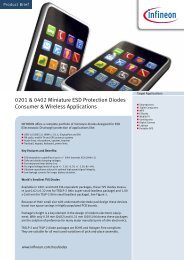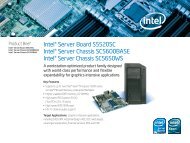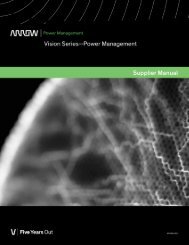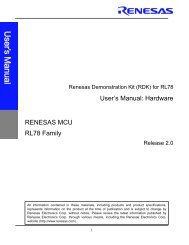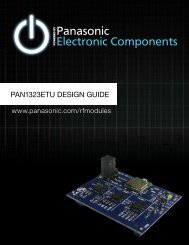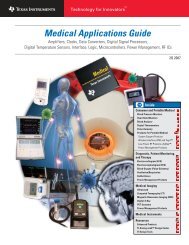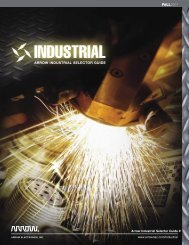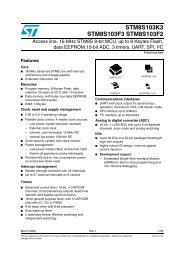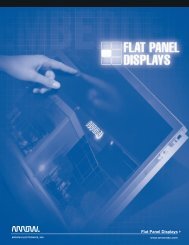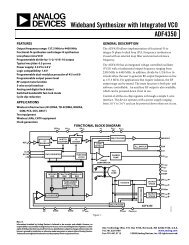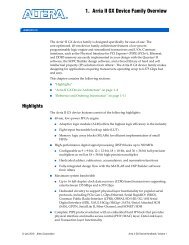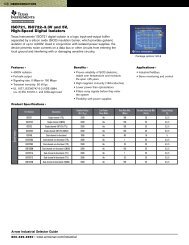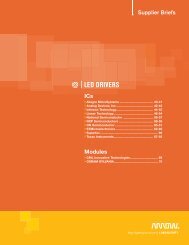Amplifier and Data Converter Selection Guide (Rev. B
Amplifier and Data Converter Selection Guide (Rev. B
Amplifier and Data Converter Selection Guide (Rev. B
- No tags were found...
You also want an ePaper? Increase the reach of your titles
YUMPU automatically turns print PDFs into web optimized ePapers that Google loves.
52 ADCs by Architecture➔Delta-Sigma (∆Σ) ADCsDelta-sigma converters are capable of veryhigh resolution, <strong>and</strong> are ideal for convertingsignals over a very wide range of frequenciesfrom DC to several megahertz. In a deltasigmaADC, the input signal is oversampled bya modulator, then filtered <strong>and</strong> decimated by adigital filter producing a high-resolution datastream at a lower sampling rate.The delta-sigma architecture approachallows resolution to be traded for speed <strong>and</strong>both to be traded for power. This nearlycontinuous relationship between data rate,resolution <strong>and</strong> power consumption makesdelta-sigma converters extraordinarily flexible.In many delta-sigma converters, thisrelationship is programmable, allowing asingle device to h<strong>and</strong>le multiplemeasurement requirements.Because delta-sigma converters oversampletheir inputs, they can perform mostanti-aliasing filtering in the digital domain.Modern VLSI design techniques havebrought the cost of complex digital filters farbelow the cost of their analog equivalents.Formerly unusual functions, such assimultaneous 50Hz <strong>and</strong> 60Hz notch filtering,are now built into many delta-sigma ADCs.Typical high-resolution applications fordelta-sigma ADCs include audio, industrialprocess control, analytical <strong>and</strong> testinstrumentation <strong>and</strong> medical instrumentation.Recent innovations in ADC architectureshave led to a new class of ADC architecturewhich uses both the pipeline <strong>and</strong> theoversampling principle.These, very high-speedconverters push the data rates into the MSPSrange, while maintaining resolutions of16-bits <strong>and</strong> higher.These speeds enable ahost of new wide b<strong>and</strong>width signal processingapplications such as communications <strong>and</strong>medical imaging.Most delta-sigma ADCs have inherentlydifferential inputs. They measure the actualdifference between two voltages, instead ofthe difference between one voltage <strong>and</strong>ground. The differential input structure of adelta-sigma makes it ideal for measuringdifferential sources such as bridge sensors<strong>and</strong> thermocouples. Frequently, no inputamplifiers are required for theseapplications.Delta-sigma converters work differently thanSAR converters. A SAR takes a "snapshot" ofan input voltage <strong>and</strong> analyzes it to determinethe corresponding digital code. A delta-sigmameasures the input signal for a certainperiod of time <strong>and</strong> outputs a digital codecorresponding to the signal's average overthat time. It is important to remember theway delta-sigma converters operate,particularly for designs incorporatingmultiplexing <strong>and</strong> synchronization.It is very easy to synchronize delta-sigmaconverters together, so that they sample atthe same time but it's more difficult tosynchronize a delta-sigma converter to anexternal event. Delta-sigma converters arehighly resistant to system clock jitter. Theaction of oversampling effectively averagesthe jitter, reducing its impact on noise.AnalogInputDifferential<strong>Amplifier</strong>DACModulatorIntegratorMany delta-sigma converters include inputbuffers <strong>and</strong> programmable gain amplifiers(PGA). An input buffer increases the inputimpedance to allow direct connection to highsource impedance signals. A PGA increasesthe converter’s resolution when measuringsmall signals. Bridge sensors are an exampleof a signal source that can take advantage ofthe PGA within the converter.Every ADC requires a reference, <strong>and</strong> forhigh-resolution converters, low-noise,low-drift references are critical. Mostdelta-sigma converters have differentialreference inputs.The following pages provide a broad rangeof delta-sigma ADCs available fromTI for a wide range of applications.To help facilitate the selection process,an interactive online data converterparametric search engine is available atdataconverter.ti.com with links to alldata converter specifications.ComparatorDigitalFilterDelta-sigma ADCs consist of a delta-sigma modulator followed by a digitaldecimation filter. The modulator incorporates a comparator <strong>and</strong> integrator in afeedback loop with a DAC. The loop is synchronized by a clock.DigitalOutput<strong>Amplifier</strong> <strong>and</strong> <strong>Data</strong> <strong>Converter</strong> <strong>Selection</strong> <strong>Guide</strong> Texas Instruments 3Q 2007



